Mga Tradisyunal na Batek at Disenyo
written by Amy C. Peria and Darren Sana
This teaching module on Philippine traditional tattoos and motifs is designed for high school students. However, it can be modified to teach college/university students. We use Philippine folklore and videos to discuss traditional tattoos and motifs in the Philippines and promote critical thinking about Philippine traditions and the present society.
Motivating Activity
This section will introduce you to the concept of tattoos and their meanings, drawing connections to familiar cultural references.
1. Introduction & Personal Connection
Last class, we talked about Ang Aking Pamilya (our family). Let’s start by thinking about tattoos in our own lives.
- Ask students if anyone in their family has tattoos. If not, ask if they know anyone else with a tattoo and if they know its meaning.
Practice Sentence Structure:
Ang _______ ko ay may tattoo na ______________.
Ang kahulugan (meaning) nito ay _______________.
Example: Ang tatay ko ay may tattoo na cross. Ang kahulugan nito ay ang kaniyang pananampalataya (belief) sa diyos.
2. Connecting to Popular Culture: Disney’s Moana
Have you watched the Disney movie Moana? Let’s explore how tattoos are depicted in this film.
- Guide Questions:
- Who is Maui?
- What did he do?
- If you know about his legend, which one is your favorite?
- Show clips from Moana showing Maui’s tattoos. For each clip, ask students what they think it means, then provide its meaning. (Consider embedding a short video compilation or using image galleries for each tattoo).
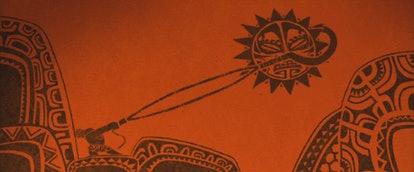
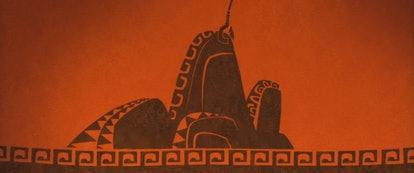
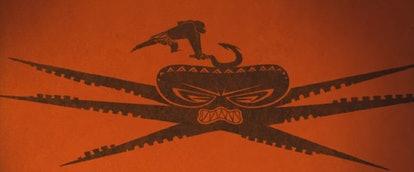
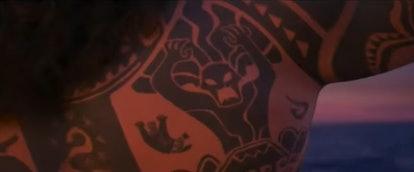
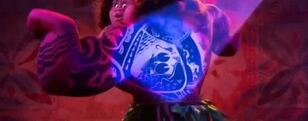
- Play the song “You’re Welcome” from the Disney movie Moana.
- Guide Question
- Pay attention to the lyrics and note down what are the legends of Maui?
- What other tattoos were shown in the video that was not already mentioned in previous slides?
- What are Maui’s personalities? What do you think of Maui?
3. Discussing Perceptions of Tattoos
Let’s discuss our opinions and common perceptions about tattoos.
- Ask students what their opinion is of a person with a tattoo:
Kung may tattoo ang isang tao, ang taong iyon ay ____________.
If someone has a tattoo, it means that person is ________________.
Suggested list of adjectives:
- matapang: strong
- marumi / madumi: dirty
- mayabang: arrogant
- kaakit-akit: attractive
- malinis: clean
- mahina: weak
- maaasahan: reliable
- magalang: respectful / polite
- tuso: cunning
- matigas ang ulo: stubborn
- pilyo/pilya: naughty
- masagwa: immodest/obscene
- gwapo: handsome
- mahinahon: calm / soft-spoken
- sikat: popular/famous
- maalalahanin: thoughtful
- kulubot: wrinkled
- inosente: innocent
Processing Activity Part 1: Indigenous Tattoo History
Dive into the rich history of traditional tattoos in the Philippines, focusing on different regions and their unique practices.
People of the Cordillera Mountain
- There are at least five provinces – Benguet, Mountain Province, Apayao, Ifugao, Kalinga – in the northern part of the Philippines.
- There are at least six ethnolinguistic groups in the Cordillera region: Isneg, Kalinga, Bontoc, Ifugao, Kankanay, and Ibalay.
Iffiallig (People of Barlig)
- The Iffialig live in Barlig, Philippines. Barlig is a remote town in Mountain Province, in the Northern Philippines.
- Oral literature and traditions were passed down through generations.
- The Ator, the village council-house, served as an educational space.
- Men from tribes of Kalinga, Bontoc, and Ifugao practice tattoo rituals called pagbabatuk. The women also have tattoos on their body, which is believed to increase their beauty and fertility.
- Tattoos for men mark the beginning of their journey from a headhunter to a fearsome warrior.
- Gulot tattoo: banded stripe pattern; received when a headhunter makes his first kill. When he makes his second kill, he can have another tattoo placed in his hands. The more kills he makes, the more intricate his tattoos become.
- Mai’ngor: highest level warrior. They have tattoos on the cheeks signifying that he is a warrior of the highest level.
Kalinga Group
(Consider placing an image of Kalinga tattoos or the Kalinga region here if available.)
Credit: Tom Kips, November 2010.
- Kalinga calls its traditional tattooing batek. It is derived from the sound of tapping of a stick on the tattoo instrument which pierces the skin. The needle is a thorn from a kalamansi / lemon tree.
- Tattoos are expressions and ingrained symbols used as visual markers to symbolize a person’s advancement in the Kalinga community.
- Examples of tattoos in the Kalinga region:
- Men were tattooed elaborate insignias on the side of their stomach, back, thighs, legs, or cheeks to symbolize their bravery and fierceness. These tattoos would signify that they are a part of the warrior class.
- Dakag tattoo: found on the back of a warrior, which recognizes a warrior’s exceptional and unsurpassed bravery.
- Pregnant women have small x-marks found on the forehead, or both sides of the cheeks and nose, which is believed to provide protection from evil spirits that dwell in their village. These evil spirits are believed to be spirits of enemies killed by the warriors and are seeking revenge by taking away the children. The x-marks are to confuse the spirits and be unable to recognize the person they want to exact revenge upon.
- Females have tattoos found mainly on their neck, shoulder blades, and on the arms.
- Young women are tattooed with the design of centipedes on their arms, neck, and shoulder blades after their first menstruation. The tattooing is believed to help the smooth flow of blood and marks that the woman is biologically ready to have children, which is a prerequisite for marriage.
Photo credit: https://www.aswangproject.com/beautiful-history-symbolism-philippine-tattoo-culture/
Motifs from Northern Luzon
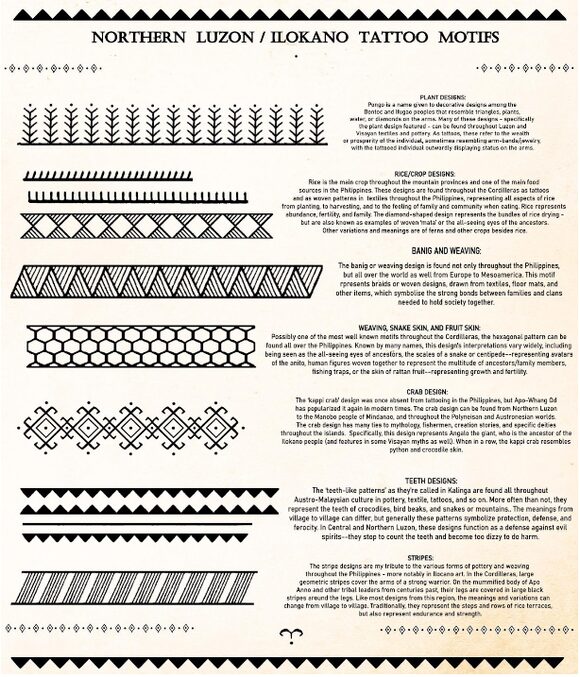
- “Millipede’s many legs stand for all people [in the village]. We have to walk with the same rhythm, then we can achieve anything.” – Whang Od
- (Consider placing an image of a Northern Luzon motif or Whang Od here.)
Cebuanos (Visayas Region)
- Pre-colonial Cebu: The people were tattooed for every brave thing they do. Even women were tattooed but would only get tattoos on their arms.
- The tattoos were a mark of a warrior and badge of honor. One’s strength, ability, rank, and honor can be identified by their tattoo.
- When Ferdinand Magellan and his crew arrived on the islands of Cebu in 1521, they encountered men who were “painted” and called them “Pintados” (the painted ones). However, these men were not painted, they were tattooed.
- Lapu Lapu was the chief of Mactan in the Visayas during the arrival of Ferdinand Magellan. He had tattoos.
Motifs from Visayas
- Labid: inch-wide vertical design that resemble a snake or crocodile’s scale pattern zigzagging from one’s legs to their waist.
- Bangut: exclusive tattoo design for the face of warriors, resembling the gaping jaw of crocodile or sometimes the face of an eagle.
- Certain tattoos were done or applied on certain parts of the body: ablay (for shoulder), dubdub (for chest) and daya-daya (for arms).
Processing Activity Part 2: Exploring Narratives & Practices
This section delves deeper into traditional tattoo practices through storytelling and video analysis.
1. Watch “Uwak at Fianyas” (Crow and Lizard)
- Discuss “Uwak at Fianyas” with the students.
- Guide Questions:
- What are your initial thoughts on Uwak and Fianyas?
- What did they gather? What did they do with it?
- What happened that made Uwak upset?
- What is the difference between Uwak and Fianyas?
- Describe how Uwak and Fianyas tattooed each other. What was different between them?
- Any stories you would like to share about traditional tattoos? Or the creation of traditional tattoos from your culture?
- Based on the personalities of iguanas and crows, what should have been their tattoos? Share with the students the photo of the motifs.
2. Watch “Whang Od: The Last Mambabatok”
- Discuss the video with the students.
- Guide Questions:
- Who is Whang Od? (Magbabatuk: tattoo artist)
- She is the only one who practices the traditional tattoo ritual in Kalinga and is currently training her niece to preserve the culture.
- Who gets to have a tattoo?
- How does one get a tattoo?
- Describe the rituals in the video.
- Slaughtering a pig to see if the visitors are welcome based on the shape of the pig’s liver.
- What is the traditional tattoo process?
- What are the tattoo designs mentioned and its meaning?
- What do you think about this traditional way of tattooing? Would you get one from Whang Od?
- Did Uwak and Fianyas use the traditional form of tattooing?
- Who is Whang Od? (Magbabatuk: tattoo artist)
3. Critical Thinking & Discussion
- Discuss with the students: What if everyone in society received a tattoo for every brave thing they do like pre-colonial Philippines?
- Discuss with the students: What are common stereotypes regarding tattoos or people with tattoos? Do you think these are true?
Culminating Activity: Design Your Own Tattoo
Apply what you’ve learned by designing a personal tattoo and presenting its meaning.
Task: Design and Present a Personal Tattoo
- Teachers should create a list of vocabulary for tattoo ideas:
- waves: alon
- mountains: bundok
- bulaklak: flower
- araw: sun
- tala: star
- buwaya: crocodile
- (Add more relevant vocabulary as needed)
- Task the students to design and draw their personal tattoo.
- If they do not want a personal tattoo, task them to design a tattoo for a family member or a friend.
- Each student should present their design and what their design means to them. Students should create an introduction and conclusion in Tagalog. Instruct students to present using as much Tagalog words they can. Taglish should be welcomed!
Guide Questions for Presentation:
- Would you get a tattoo? What would you include in your designs?
Gusto ko ng tattoo dahil _________________.
Ayaw ko ng tattoo dahil _________________.
Example: I would like mountains. Gusto ko ng bundok.
- If you already have one, what is the story or reason behind it?
May tattoo ako ng ____________. Ang istorya nito ay _____________.
Mayroon akong tattoo. Ito ay _____________.
Wala akong tattoo dahil ____________________.
- Colors: Color + ligature (-ng, na, -g) + object
- What are significant designs and colors in your culture?
- What is the significance of traditional tattoos and motifs to you? To your culture?
- Are the stereotypes behind tattoos still prevalent and relevant today?
Enrichment Activity (Optional)
- Students may ask their family members or friends who have tattoos about the meaning of their tattoos.
- Ask students to watch more videos on Whang Od, the Cordillera Province, and the Visayas region.
Resources
- “Beads, Batok, and Beauty: Philippine Traditions of Adornment” Presented by: Dr. Raju Desai
- The Globalization of Kalinga Tattoos, From the Philippiens to the U.S.A., Tom Kips.
- Reviving the art of Filipino tribal tattoos, Aya Lowe.
- The Beautiful History and Symbolism of Philippine Tattoo Culture, Daniel de Guzman.
- List of Filipino adjectives.